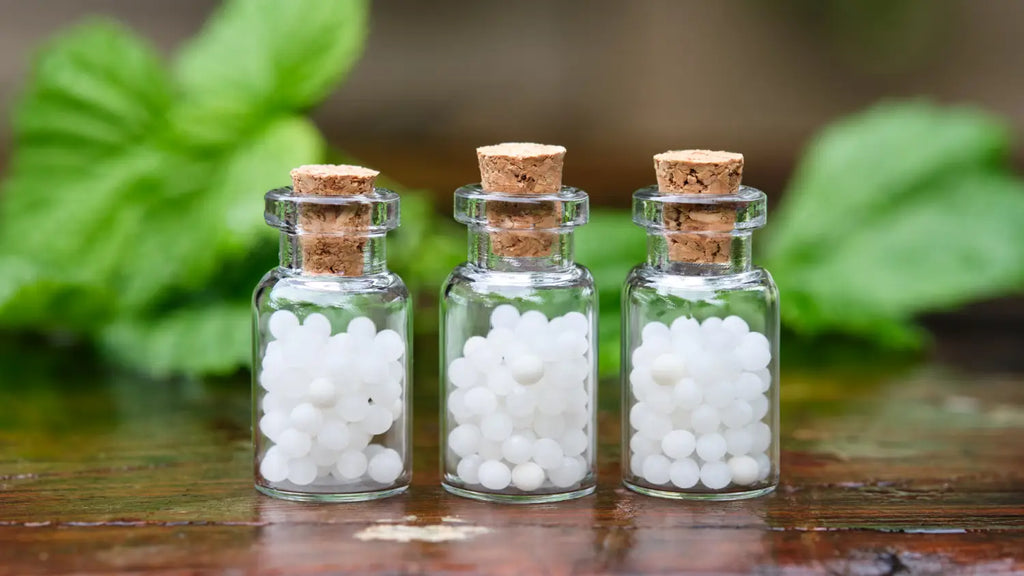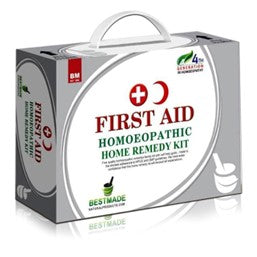
Homeopathic Remedies vs. Tissue Cell Salts: Differences, Benefits, and When to Use Each
Two popular choices often come up in natural remedies: homeopathic remedies and tissue salts. In this blog, we'll explore these two options, understand their differences, and learn about their benefits and effectiveness. We'll also look at common health problems they are commonly used for.
If you're curious about these natural solutions, let's understand how they can support your health and wellness.
Economy Pack Schuessler Tissue Cell Salt Kit provides natural support to boost immunity and stimulate natural healing. Aims to provide cellular nutrition vital to cellular function.
What Are Homeopathic Remedies and How Do They Work?
Homeopathic remedies are a type of alternative medicine that uses highly diluted substances to address different health concerns. The main idea behind homeopathy is “like cures like”: meaning a substance that causes symptoms in a healthy person can, in a very diluted form, be used to help ease similar symptoms in someone who is unwell.
Here’s how homeopathic remedies are made and used:
-
Dilution: A natural substance, such as a plant or mineral, is diluted in water or alcohol. This process is often repeated many times until the original substance is almost undetectable in the final product.
-
Succussion: After each dilution, the mixture is shaken vigorously, a step called “succussion.” Homeopaths believe this activates the substance’s healing properties.
-
Potency: Remedies are labeled by potency, such as 6X or 30C. The higher the number, the more diluted, and therefore more potent, the remedy is considered. For example, a 30C remedy is more diluted than a 6X.
-
Individualization: Homeopathic treatment is highly personalized. When selecting a remedy, homeopaths look at not only the physical symptoms but also the patient’s emotional and mental state.

What Are Tissue Cell Salts and How Are They Different?
Tissue salts (also called cell salts or Schüssler salts) are a specific branch of homeopathic remedies. They were developed in the 19th century by German doctor Wilhelm Heinrich Schüssler. The concept is based on the belief that imbalances in the body’s 12 essential minerals can contribute to various health issues. These minerals include important substances like calcium, potassium, and magnesium.
Here’s how tissue salts are used:
-
Deficiency Support: Tissue salts are thought to help correct imbalances or deficiencies in the body’s essential minerals. For instance, a calcium tissue salt might be chosen if someone is low in calcium.
-
Low Potency: Unlike many higher-potency homeopathic remedies, cell salts are prepared in low potencies. This means they are less diluted and intended to gently support the body’s mineral balance.

What’s the Difference Between Homeopathy and Cell Salts?
-
Substance Source: Homeopathic remedies can be made from many natural substances, including plants, minerals, and even animal products. Tissue salts, on the other hand, focus only on the 12 essential minerals.
-
Dilution Level: Homeopathic remedies are often highly diluted (sometimes to the point where the original substance may no longer be present in the final product). Tissue salts are usually prepared in low potencies, meaning they are less diluted.
-
Purpose: Homeopathic remedies are chosen to match a person’s overall state and symptoms, aiming to address a wide variety of health concerns. Tissue salts are mainly used to support the body’s mineral balance.
-
Individualization: Homeopathy emphasizes a highly individualized approach, considering a person’s unique symptoms, personality, and constitution. Tissue salts are typically chosen more simply, based on signs of mineral deficiency or imbalance.
In summary: Both homeopathic remedies and tissue salts use diluted substances, but they differ in focus. Tissue salts are designed to gently support mineral balance, while homeopathic remedies have a broader application and are guided by the principle of “like cures like.”
Homeopathic Remedies vs. Tissue Cell Salts: Quick Comparison
|
Feature |
Homeopathic Remedies |
Tissue/Cell Salts (Schuessler) |
|
What they are |
Highly diluted preparations from plants, minerals, or other natural sources |
12 specific mineral salts already present in the body |
|
Core idea |
“Like cures like” + individualization |
Gently supports mineral balance at the cellular level |
|
How chosen |
Matched to a person’s unique symptom picture (holistic profile) |
Matched to tissues/functions (e.g., nerves, skin, fluids) or common patterns |
|
Typical potencies |
X, C, M (often higher dilutions like 30C) |
Usually low potencies (e.g., 6X, 8X) |
|
Use cases |
Broad range: colds, stress, sleep, digestion, etc. |
Everyday mineral support: hydration, skin/hair/nails, cramps, digestion, nerves |
|
Dosing style |
Single or combinations |
Single or combinations |
|
Works with… |
Lifestyle practices, conventional care |
Lifestyle practices, conventional care |
|
Safety & interactions |
Generally well tolerated |
Generally well tolerated |
Which one should I choose?
-
Choose a homeopathic remedy if you want a remedy matched to your exact symptom pattern (e.g., a specific kind of headache or a stress profile).
-
Choose cell salts if you want simple, daily support for mineral balance (hydration, muscle comfort, skin/nails, digestion, general resilience).
-
Use both if you like: many people take a cell salt remedy (like BIO28) for baseline support and add an individualized homeopathic remedy during flare-ups.
People turn to homeopathic remedies and tissue salts for lots of different reasons. Here are some of the most common ones:
-
Gentle on the body: Since they’re highly diluted, they’re generally seen as gentle and easy to take, without the heavy side effects that can come with some medicines.
-
Personalized feel: In homeopathy, remedies are often chosen to match a person’s unique situation: their symptoms, mood, and overall state.
-
Non-invasive: No needles, no surgeries. Just simple remedies that fit easily into everyday routines.
-
Whole-person approach: Many people like that homeopathy looks at the bigger picture, addressing the root cause of issues.
-
Supports balance: Remedies are often seen as supporting the body’s own way of finding balance and feeling better.
-
Easy to combine: Because they’re so diluted, they’re generally considered safe to use alongside other medications people may already be taking.
-
Budget-friendly: Compared to many conventional treatments, they’re often more affordable.

First Aid Home Natural Remedy Kit Bundle includes a full cell salt kit and full-sized bottles of remedies. It takes care of immediate health needs.
Common Issues Homeopathic Remedies Are Used For
People often turn to homeopathic remedies for a wide range of everyday concerns. Some of the most common include:
-
Colds: Remedies are selected to match signs like congestion, runny nose, or cough.
-
Allergies: Many people turn to homeopathy for sneezing, itchy eyes, or skin irritation during allergy season.
-
Sleep Troubles: Options are considered for difficulty falling asleep, restlessness, or waking too early.
-
Stress and Anxiety: Remedies are tailored to support calm and balance during times of tension or overwhelm.
-
Headaches and Migraines: Different remedies may be chosen depending on the type and location of the aches.
-
Skin Conditions: Concerns like acne or eczema are often addressed with homeopathic remedies chosen to support the look and feel of the skin.

Cell salts are a simple, everyday way to support balance and well-being. They’re most often used for things like:
-
Digestive Upset: Gentle support when there’s bloating, indigestion, or acidity.
-
Skin and Hair: Often used to promote clearer skin and stronger hair and nails.
-
Muscle Cramps and Spasms: A natural option people reach for with sharp cramps or tension in the muscles.
-
Fatigue and Low Energy: Many turn to cell salts for a gentle pick-me-up when feeling run down.
-
Nervous Tension: Popular for times of stress, irritability, or mental exhaustion.
-
Bone and Teeth Support: Often used to support strong teeth and bones at any stage of life.
-
Menstrual Discomfort: Used by women for cramps, irregular cycles, or monthly discomfort.

FAQ
Can I take cell salts and a homeopathic remedy together?
Yes, many people do. Cell salts are generally used for baseline mineral support, while a homeopathic remedy is chosen for a specific symptom picture.
Are cell salts just “weak homeopathy”?
Not really. Cell salts are a special branch of homeopathy that focus only on 12 essential mineral salts in low potencies. Regular homeopathy matches remedies to a person’s unique symptom picture, while cell salts are all about supporting your body’s basic mineral balance and healthy cell function.
Are they safe for the whole family? Do they interact with medications?
Yes. Cell salts are generally considered safe for all ages, and they don’t interfere with medications or supplements. Just be sure to use them as directed. If you’re managing a specific health condition, it’s always a good idea to check in with a qualified practitioner.
What potency should I pick?
Homeopathic remedies and cell salts come in different strengths, called potencies. Lower potencies (like 6X or 30C) are great for everyday, minor concerns.
Higher potencies (like 12X, 200C, or above) are usually chosen for stronger or longer-lasting support. If you’re not sure which to use, check with a practitioner.

The Bottom Line
Both homeopathic remedies and cell salts are used as gentle and non-invasive options for everyday wellness. If you want simple, daily mineral balance, start with cell salts. If you prefer a remedy matched to your individual symptoms, explore homeopathic remedies.
Many people have found support for digestive problems, skin conditions, and more through these remedies, so be sure to try them.
If you want to learn more about cell salts, visit our Complete Guide to Cell Salts.
You might also be interested in:




Laissez un commentaire